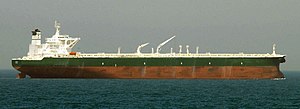
Back Olietenkskip Afrikaans ناقلة نفط Arabic Neft tankeri Azerbaijani نفت گمیسی AZB Петролен танкер Bulgarian তেলবাহী জাহাজ Bengali/Bangla Petrolier Catalan Tancer olew Welsh Öltanker German Πετρελαιοφόρο Greek
 The commercial oil tanker AbQaiq, in ballast
| |
| Class overview | |
|---|---|
| Name | Oil tanker |
| Subclasses | Handysize, Panamax, Aframax, Suezmax, Very Large Crude Carrier (VLCC), Ultra Large Crude Carrier (ULCC) |
| Built | c. 1963–present |
| General characteristics | |
| Type | Tank ship |
| Tonnage | up to 550,000 DWT |
| Notes | Rear house, full hull, midships pipeline |
An oil tanker, also known as a petroleum tanker, is a ship designed for the bulk transport of oil or its products. There are two basic types of oil tankers: crude tankers and product tankers.[3] Crude tankers move large quantities of unrefined crude oil from its point of extraction to refineries.[3] Product tankers, generally much smaller, are designed to move refined products from refineries to points near consuming markets.
Oil tankers are often classified by their size as well as their occupation. The size classes range from inland or coastal tankers of a few thousand metric tons of deadweight (DWT) to ultra-large crude carriers (ULCCs) of 550,000 DWT. Tankers move approximately 2.0 billion metric tons (2.2 billion short tons) of oil every year.[4][5] Second only to pipelines in terms of efficiency,[5] the average cost of transport of crude oil by tanker amounts to only US$5 to $8 per cubic metre ($0.02 to $0.03 per US gallon).[5]
Some specialized types of oil tankers have evolved. One of these is the naval replenishment oiler, a tanker which can fuel a moving vessel. Combination ore-bulk-oil carriers and permanently moored floating storage units are two other variations on the standard oil tanker design. Oil tankers have been involved in a number of damaging and high-profile oil spills.